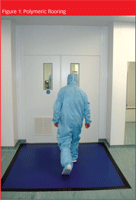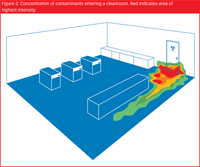Selecting The Right Cleanroom Solutions
Pharmaceutical Technology Europe
Contamination in all its forms should be identified and reduced whenever and wherever possible.
This article is part of a special feature on cleanrooms that was published in the December issue of PTE Digital.
Contamination in all its forms should be identified and reduced whenever and wherever possible. The best managed cleanrooms/critical environments start at the entrance to the building and implement a holistic contamination control programme, starting with basic entrance matting to reduce the ingress of mud, grit, water and gross contamination, and becoming progressively cleaner as you get nearer to the critical area.
Figure 1: ECO–1 control panel with 2 way data flow.

The specifics of the exact products, processes and protocols required largely depend on the class of cleanroom, number of staff, frequency of cleaning and future company improvement goals; for example, reducing environmental impact.
Mark Dalziel

Normal solutions comprise some form of workwear, such as a lab coat and work shoes, to a washable or disposable cleanroom suit with facemask, hat, gloves. There will also be one form of contamination control flooring protection system at all entrances and exits to the critical areas, such as airlocks, changing rooms, and transfer hatches.
Detergent selection
When selecting detergents for cleanrooms, it is necessary to rotate the solutions used at regular intervals as germs become more resistant to a specific cleaner. It takes a lot of time and money to validate a new cleaning detergent/product; this is accepted as a necessary investment because if the cleaning solution fails and contamination enters the clean area, the costs can be prohibitive.
To select the right solutions, companies must first consider how clean they need the clean area to be, i.e., what are the allowed viable and non viable counts pass fail rates?
The cost of cleaning in the cleanroom is always far higher than cleaning outside the cleanroom; hence everything that can be done to keep the dirt out is highly cost effective, such as the use of polymeric flooring. It is widely accepted that around 80% of all contaminants entering a cleanroom do so through entrances and exits at or near floor height (Figure 2).
Figure 2: Concentration of contaminants entering a cleanroom. Red indicates area of highest intensity.

Time is also a consideration; one must define how long one cleaning system takes versus another. Also, how aggressive is the cleaning system? The answer is usually a trade off between killing everything very quickly, and risk ruining other sensitive and even nonsensitive equipment. I have even seen stainless steel eaten away by aggressive cleaning systems so beware!
Before introducing new protocols, proper validation is vital as the "magic" new solution may not be quite as it first appears!
Environmental considerations
All pharmaceutical companies place a great deal of importance on continuous good manufacturing practice (cGMP). In today's world, environmental improvement is a key goal and there is often a lot of wasted electrical energy from using HEPA or UPLA filters to control the class of cleanroom or mini environment. Also, the use of disposable or consumable products when longer term options are readily available simply seems a waste of resources. A couple of obvious examples are the use of disposable Tyvek suits versus washable, reusable cleanroom clothing, and using peel off sticky mats instead of the environmentally friendly, polymeric contamination control systems.
The best way of ensuring a long active life of a cleanroom and its equipment is to slightly over engineer the cleanroom and standard operating procedures in the first place so changes and upgrades can easily be accommodated. If this is not done, then companies will be continuously working hard to meet the standards needed, which is going to be both costly and time consuming.
Pharmaceutical Tariffs Are Imminent: How Industry is Bracing for Impact
April 16th 2025On April 14, 2025, the Trump Administration launched a national security-driven investigation into pharmaceuticals, a move that will likely result in tariffs being placed on pharmaceutical drugs, ingredients, and other components that are imported from outside of the United States.
Drug Solutions Podcast: A Closer Look at mRNA in Oncology and Vaccines
April 30th 2024In this episode fo the Drug Solutions Podcast, etherna’s vice-president of Technology and Innovation, Stefaan De Koker, discusses the merits and challenges of using mRNA as the foundation for therapeutics in oncology as well as for vaccines.
